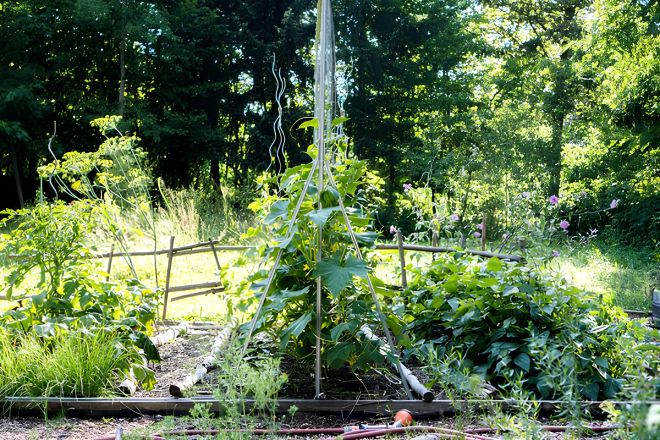Intercropping in the Vegetable Garden
With cool-season crops wrapping up and warm-season crops still going in, I recently found myself in a predicament many vegetable gardeners may be all too familiar with. My spring crops were slow to develop this year, stifled by sporadic frosts and bouts of dry weather. However, the warm-season transplants I had ordered to fill the place of the spring crops were right on schedule and needed space for planting that wasn’t yet available. Thus, when the time arrived for transplanting said crops, the beautiful, congruently rowed layers of vegetables I had envisioned for the year quickly took a more adaptive approach. What was left in their wake was a patchwork of sorts, with tomatoes and peppers strewn about in the open square footage and wider spaces between spring crops. And even with this resiliency in planting, the question ultimately begged… Is this going to work?
Intercropping, or growing two or more crops within the same growing space, can be tricky but successful when done carefully. As with all plants, vegetables compete against each other for space, light, water, and nutrients, which is the typical reason they are planted in rows, abiding by spacing recommendations. On top of this, vegetables also perhaps need even more maintenance “working room” than ornamentals, specifically because of the requirement for harvesting room. Still, when looking at growth habits, nutrient utilization, and watering needs, space can sometimes be shared successfully with some finessing. This careful planning and proactive approach are key to successful intercropping.
When considering intercropping, gardeners should start with the basics. Ask, 'What are the water and drainage requirements of the plants I want to intercrop, and do they match?' If they can utilize the same level of soil moisture, light can then be considered. Rather than matching in this instance, consider plant growth forms and whether the potential shade generated can be utilized. Perhaps the shade will only be in the late afternoon, shielding fruit from the hot summer sun. Or perhaps there isn’t much shade, and both plants can adequately photosynthesize in the space. Then, nutrients should also be considered, remembering that factors like a high nitrogen level can inhibit production in fruiting vegetables while increasing production for leafy ones. This concept of 'space sharing' is crucial in intercropping, as it allows you to optimize your garden space and ensure that each plant gets the resources it needs.
While these factors leave much to be considered, they are not without their merit. Intercropping, despite its challenges, can lead to improved crop yields, disrupted pest and disease spread, enhanced soil biodiversity, erosion control, and more. Consider classic pairings such as fast-producing radishes with slow-growing carrots, tall tomatoes with shade-utilizing lettuce (bearing in mind nutrient differences), and below-ground potatoes with above-ground bush beans. The possibilities are numerous, and the potential benefits are truly inspiring.
While scientifically compatible, are all possibilities foolproof and without the risk of additional transplanting and relocation? No. You will especially want to be careful when remembering crops with similar pests and diseases and those that don’t appreciate having their roots disturbed. Nevertheless, in a bind, intercropping can be a useful, if temporary, tool to help carry plants through time-sensitive windows.
by Anthony Reardon, Horticulture Small Farms Agent, 2025